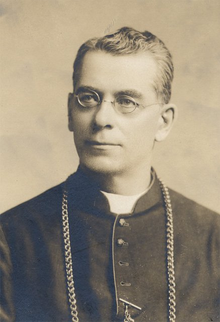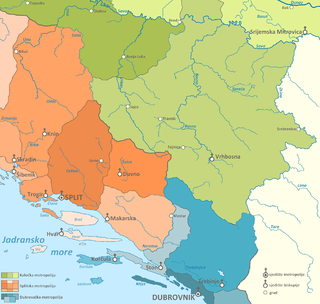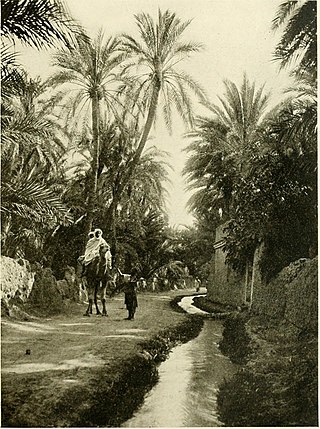
Eleutheropolis in Palaestina is a titular see of the Roman Catholic Church located in modern Israel. [1] The position of bishop is vacant.

Eleutheropolis in Palaestina is a titular see of the Roman Catholic Church located in modern Israel. [1] The position of bishop is vacant.
In A.D. 200 Septimius Severus founded a Roman colony on the site of a previous Jewish town, Maresha, destroyed by Vespasian 130 years earlier. [2] The new colony grew quickly, [3] due to its location on important trade routes and in 325 it became the site of an episcopal see in Palaestina Prima, with Macrinus as first bishop.
Eusebius of Caesarea an important early church writer who lived at this time and was based from this Bishopric used it as a starting point for measuring distances of other locations.
We know of only six bishops, with Macrinus, and Zebennus being the only ones named, there are another four for whom we don’t know their name.
Church texts mention 50 soldiers who were executed here in 638 for not abandoning the Christian religion following the arrival of Islam. Their burial site is in the vicinity of the town. The diocese ceased to function effectively from this time.
The last titular bishop was Alfred Matthew Stemper . [4]

A bishop is an ordained member of the clergy who is entrusted with a position of authority and oversight in a religious institution. In Christianity, bishops are normally responsible for the governance and administration of dioceses. The role or office of the bishop is called episcopacy. Organizationally, several Christian denominations utilize ecclesiastical structures that call for the position of bishops, while other denominations have dispensed with this office, seeing it as a symbol of power. Bishops have also exercised political authority within their dioceses.
In the Acts of the Apostles, Joseph Barsabbas was one of two candidates qualified to be chosen for the office of apostle after Judas Iscariot lost his apostleship when he betrayed Jesus and committed suicide. After the casting of lots he was not chosen, the lot instead favoring St. Matthias to be numbered with the remaining eleven apostles.
The hierarchy of the Catholic Church consists of its bishops, priests, and deacons. In the ecclesiological sense of the term, "hierarchy" strictly means the "holy ordering" of the church, the Body of Christ, so to respect the diversity of gifts and ministries necessary for genuine unity.
The archiepiscopal see of Caesarea in Palaestina, also known as Caesarea Maritima, is now a metropolitan see of the Eastern Orthodox Patriarchate of Jerusalem and also a titular see of the Catholic Church. It was one of the earliest Christian bishoprics, and was a metropolitan see at the time of the First Council of Nicaea, but was later subjected to the Patriarchate of Jerusalem. The city remained largely Christian until the Crusades, its bishop maintaining close ties to the Byzantine Empire. After the establishment of the Kingdom of Jerusalem by the crusaders, the see was transformed into a Latin archdiocese, subordinate to the Latin patriarch of Jerusalem.

The Catholic Church in Togo is part of the worldwide Catholic Church, under the spiritual leadership of the Pope in Rome.

The Metropolitan Archdiocese of Madrid is a Latin archdiocese of the Catholic Church in Spain. It is one of Spain's fourteen metropolitan archbishoprics. Since 12 June 2023 the archbishop of Madrid has been José Cobo Cano.

In the Catholic Church, a bishop is an ordained minister who holds the fullness of the sacrament of holy orders and is responsible for teaching doctrine, governing Catholics in his jurisdiction, sanctifying the world and representing the Church. Catholics trace the origins of the office of bishop to the apostles, who it is believed were endowed with a special charism and office by the Holy Spirit at Pentecost. Catholics believe this special charism and office has been transmitted through an unbroken succession of bishops by the laying on of hands in the sacrament of holy orders.

The Archdiocese of Morelia is a Latin Church ecclesiastical territory or archdiocese of the Catholic Church in western central Mexico. It was erected on 11 August 1536 as the Diocese of Michoacán.

The Roman Catholic Archdiocese of Nyeri is the Metropolitan See for the ecclesiastical province of Nyeri, one of four in Kenya, Eastern Africa, yet depends on the missionary Roman Congregation for the Evangelization of Peoples.
The diocese of Nepi-Sutri was a Roman Catholic ecclesiastical territory in central Italy, created in 1435 by unifying the diocese of Nepi and the diocese of Sutri. It existed until 1986, when it was united into the current diocese of Cività Castellana.

The Diocese of Terni-Narni-Amelia is a Latin Church ecclesiastical territory or diocese of the Catholic Church in Umbria, central Italy. It was created in 1983, when the Diocese of Amelia was united with the Diocese of Terni and Narni. The latter had been in turn created in 1907, when the Diocese of Narni was united to the historical Diocese of Terni. The diocese is immediately exempt to the Holy See, not part of any ecclesiastical province.

The Roman Catholic Archdiocese of Agra is a Latin Metropolitan archdiocese in northern India's Uttar Pradesh state. It comproses the following districts in Uttar Pradesh: Agra, Aligarh, Auraiya, Budaun, Bulandshahr, Etah, Etawah, Farrukabad, Firozabad, Gautambudha Nagar, Hathras, Kannauj, Mainpuri, Mathura and in Rajasthan: Bharatpur and Dholpur.
The Diocese of Trevico was a Roman Catholic diocese located in the town of Trevico in the province of Avellino, Campania, southern Italy. In 1818, it was suppressed to the Diocese of Lacedonia.

The Diocese of Korčula was a Roman Catholic diocese in Croatia, located in the city of Korčula. In 1828, it was suppressed to the Archdiocese of Dubrovnik.
The Diocese of Levello was a Roman Catholic diocese in southern Italy, located in the city of Lavello, province of Potenza, in the region of Basilicata. In 1818, it was suppressed, and its territory and members incorporated in the Diocese of Venosa.

The Diocese of Mottola or Diocese of Motula was a Roman Catholic diocese located in the town of Mottola in the province of Taranto in the region of Apulia in southeast Italy. In 1818, it was suppressed to the Diocese of Castellaneta.
The Diocese of Caorle was a Roman Catholic ecclesiastical territory in the coastal town of Caorle in the province of Venice, Veneto.

Vescera, also known as Ad Piscinam, was an ancient titular see and Roman colony in Roman North Africa. It has been identified as a site near Biskra in Algeria. It remains as a titular see of the Roman Catholic Church in the Province of Numidia.
Catholic dioceses in the Holy Land and Cyprus is a multi-rite, international episcopate in Israel and Cyprus.